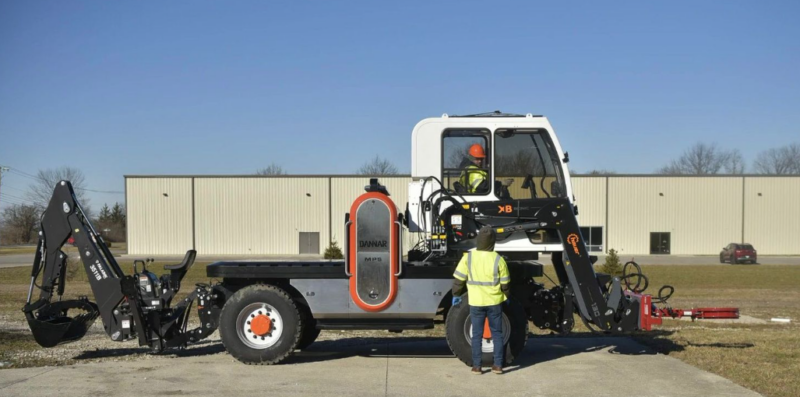
Sign up for daily news updates from CleanTechnica on email. Or follow us on Google News!
One of the advantages electric vehicles have is that their batteries can store energy to be used for purposes other than driving. Vehicle-to-grid and vehicle-to-load are some of the terms used to describe this versatility. So, if you have a Ford Lightning, Chevy Silverado EV, or Tesla Cybertruck and your home power goes out, if there is enough electricity in your pickup truck’s battery you can use that to provide electricity to your appliances.
On a larger scale and for work and industrial purposes, there is the Mobile Power Station manufactured by DANNAR. Relative to an EV for personal transportation, it is huge and multi-functional. Personally, I like this idea far better than a massive diesel generator which uses a fuel that creates toxic air pollution when combusted, is loud, and smelly. Fossil fuels are also doing a lot of harm to the planet’s atmosphere and climate. Additionally, electric batteries are more energy efficient than diesel generators.
Gary Dannar, Founder and CEO of DANNAR, answered some questions about the Mobile Power Station for CleanTechnica.
What does MPS mean, and what is the battery on wheels?
DANNAR is a global leader in clean energy technology and the pioneer of the Mobile Power Station® (MPS). Founded by Gary Dannar in 2011, DANNAR has established a new category in the developing EV industry as the first-ever self-propelled MPS that serves as both a dynamic heavy work machine with industry-standard hydraulics to power work tools and attachments, as well as an unparalleled energy storage and charging solution.
This ‘mega battery on wheels’ is capable of off-road and on road autonomous and semi-autonomous work and is capable of transporting and exporting power for increased energy resiliency through mobile micro-grids. The MPS’ modular design allows it to serve multiple industries across agriculture, utilities, construction, government fleets, airports, emergency response, military and defense, and more.
Does it have a drivetrain, or does it need to be trailed?
The MPS is a fully integrated battery system and carries its own onboard inverter, liquid cooling system, and BMW-engineered battery packs. This system is on a four-wheel drive chassis and is powered by a highly efficient electric drivetrain. The MPS powertrain includes an oscillating axle, creep and travel modes, selectable 2W and 4W (coordinated or crab), traction control and regenerative braking, and more. The MPS’ top speed is 20 MPH with a drawbar pull of 100,000 pounds with auxiliary brakes and has a 1-mile line of sight Safe Remote Control (SRC).

What is the minimum battery capacity and the maximum battery capacity?
The DANNAR MPS is available with 250 kWh and is configurable up to 500 kWh depending on the customers’ needs and desired use cases for the MPS.
What is the battery chemistry?
The DANNAR MPS uses the BMW i3 Li-Ion battery packs.
What is the cost?
The cost of an MPS is equivalent to a similar-sized construction vehicle or work vehicle you would see at construction sites, used by government fleets, etc. Specific pricing for the MPS is based on the configuration requested by the customer. The MPS is unique in that its modular design allows customers to have a multiple purpose and multi-functional vehicle in one platform. Customers can attach a cab to drive the MPS, a backhoe, mower, and much more based on their needs. Because the MPS is able to perform jobs that would usually take multiple vehicles or machines, this saves the end customer dollars, storage space, and time toward maintaining multiple machines to do the jobs they need. In addition, the MPS can provide solutions to other customers’ needs across electricity output for outdoor events, caps in EV charging, and more.
What does the warranty cover?
The warranty for the MPS covers defects in the MPS unit across the battery system, power electronics, and other components. The parts and main battery system also come with a warranty, and customers will need to make sure they register their DANNAR MPS to activate the warranty.
Who is it intended for?
The MPS is intended for customers across a wide variety of industries. Whether you are in construction and are in the process of converting your fleet to full electric, a farmer looking to use a powerhouse EV in your field, to a fleet manager looking for one vehicle that can serve multiple purposes, the MPS can serve virtually anyone.
The industries DANNAR is seeing the most interest from are construction, agriculture, fleets, military, utilities, and airports. In general, we are seeing a shift towards EVs, not just in the automotive industry, but also across big machinery. This is because EVs can supply a more constant stream of power, meet sustainability goals, are quieter, and require less maintenance. However, the gap in EV charging is something we cannot ignore. DANNAR is directly solving this gap with their MPS acting as a ‘mega battery on wheels’. The MPS can go off-road and reach massive construction EVs and provide opportunity charging during the work shift, as well as off-hour maximum charging when required. The MPS can also be used as a DC fast charger for vehicles.
The options and opportunities to use the MPS are endless, and we are excited to see how the use cases for our modular machine continue to develop.
Who are some of your customers currently?
DANNAR has customers across the agricultural, military, construction, and fleet industries.
For agriculture, we are seeing the MPS used to power their EV farming machinery, but also to help act as the farming machine itself, pulling, watering, and fertilizing attachments without damaging crops.
Across construction, we are seeing the MPS used to step in as an additional powerhouse vehicle to being used as the charger for the massive EV construction machines. The military is also exploring similar use cases with the MPS as well.
For government fleets, we are seeing customers adopt the MPS to replace multiple pieces of machinery they used to need but can now be replaced with one modular MPS. This saves customers time and dollars across storage, maintenance, and more.
In each industry, we are seeing customers continue to evolve how they are using the MPS, and with virtually unlimited attachment options, we at DANNAR are always excited to see how the MPS can be used next.
How much does it weigh?
The DANNAR MPS weighs up to 22,000 pounds and can carry a payload of about 40,000 pounds. Additionally, the MPS is about the size of a full-sized pickup truck and can fit in most standard parking spaces.
How is it recharged, and how long does a full charge take?
The DANNAR MPS can be charged in a variety of ways depending on the users’ setup. The MPS can be charged directly from grid connection, through a Level 2 AC input, using a CCS1 Level 3 DC fast charger up to 250 kW, and via 480 3-Phase. The full charge time depends on which charging option users are going with and its battery configuration; however, if the MPS is connected to the grid, it can be charged much quicker. Once the MPS is charged, depending on how customers use the MPS, it will usually be fully functional for multiple days before needing to be recharged.
What kind of electrical outputs does it have, and what can it be used to charge?
At DANNAR, we like to say the MPS can charge other machines as fast as the machines themselves can handle it. The MPS can export energy via 110 VC Output at 20 amps, 240 VAC 1P NEMA 14-50 Output, SAE-J1772 Level 2 Charger Output up to 9.6 kW. In addition, the platform can also provide a DC fast charging output and can deliver up to 120 kW of power for multiple vehicles at once.
The flexibility in the output of energy is also what makes the MPS so attractive to various industries. In fact, multiple MPSs can be tethered together to create a microgrid for backup power and emergency response needs.
Is it possible to charge it with solar power?
DANNAR’s MPS can be charged using solar power, and the MPS is a great complement to solar in a comprehensive microgrid setup. However, there are a few things to keep in mind when looking to charge the MPS using solar. A microprocessor will be needed to make the process streamlined, as the collection of solar is intermittent. Because of this, the most effective way to ensure an efficient charge is for the solar generation system itself to have its own battery. This will allow the electricity to flow steadily from one battery to another controlled by the microprocessor.
Have a tip for CleanTechnica? Want to advertise? Want to suggest a guest for our CleanTech Talk podcast? Contact us here.
Sign up for our daily newsletter for 15 new cleantech stories a day. Or sign up for our weekly one if daily is too frequent.
CleanTechnica uses affiliate links. See our policy here.
CleanTechnica’s Comment Policy



